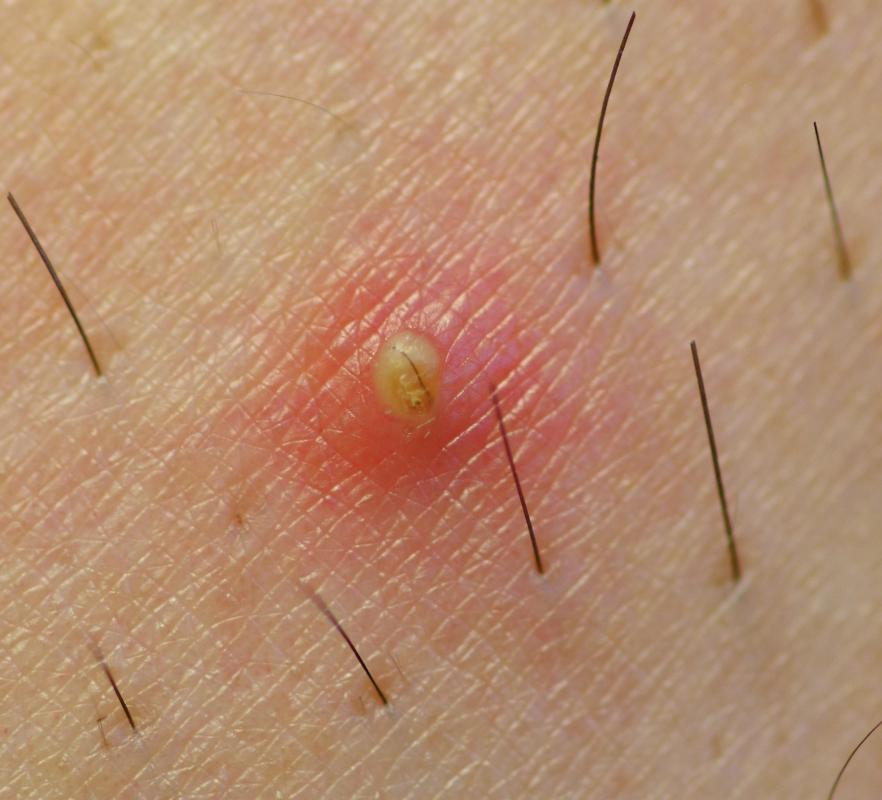At WiseGEEK, we're committed to delivering accurate, trustworthy information. Our expert-authored content is rigorously fact-checked and sourced from credible authorities. Discover how we uphold the highest standards in providing you with reliable knowledge.
How do I get Rid of Ingrown Hair Bumps?
Ingrown hair bumps, or razor bumps, can be painful nuisances. Shaving or tweezing hair on the face or body can result in a sharp edge that curls inward and penetrates the skin. When the hair doubles over into the follicle, it can cause irritation, inflammation, redness, and a persistent itch. Most ingrown hairs can be treated at home by gently scrubbing and washing the site of irritation two to three times a day. An especially difficult ingrown hair bump may be relieved by carefully pulling the end of the hair out of the skin with a sterile needle or tweezers.
Doctors encourage people to avoid scratching or rubbing ingrown hair bumps, as doing so can cause further irritation and possibly lead to a bacterial infection. Instead, most professionals recommend trying to keep the skin clean with gentle soaps and alcohol-free exfoliating products. Lightly scrubbing ingrown hair bumps with a soapy washcloth can remove excess dirt, dead skin cells, and bacteria from the site. The scrubbing motion also prompts the hair to break free from the follicle and start growing outward normally. Most ingrown hairs release within one week of careful washing.

If ingrown hair bumps persist or cause significant discomfort, a person can try to get rid of them by manually pulling the sharp edges out of the follicles. If a hair is large enough to grab with a pair of tweezers, an individual can attempt to delicately grab and pull on it. A sterile needle may be used to get just underneath the curl of a small hair without penetrating the skin. Proper washing is important after removing the hair to make sure the follicle does not get infected.

A person who has frequent, widespread, or persistent ingrown hairs should visit a dermatologist to learn about other treatment options. A doctor can manually remove hairs with specialized needles and prescribe a topical tretinoin cream to exfoliate the skin. If redness and irritation persist, the dermatologist may apply a corticosteroid cream to reduce inflammation. Oral or topical antibiotics may be provided as well if signs of infection are present.

It is not always possible to prevent ingrown hair bumps, but certain steps can be taken to reduce the likelihood of frequent problems. It is a good idea to avoid shaving an especially prone area when possible. If shaving is necessary, a person can use lubricated shaving creams and gels and sharp razor blades. Shampoos and creams designed to remove hair may be a helpful alternative to shaving, as long as they are used exactly according to directions. Alternately, a person can also opt for a semi-permanent laser hair removal procedure at a dermatologist's office.
AS FEATURED ON:
AS FEATURED ON:














Discussion Comments
My hubby has really, really oily skin and is terribly prone to ingrown hairs. He gets them on his back and stomach, mostly.
He had one place on his stomach that was itching fiercely, so I looked at it and could tell it had festered. I squeezed it and pus c came out, and the hair was very curly, so I got the tweezers to pull it out. Apparently, the hair was attached to a sebaceous gland and had blocked it or something because, along with the hair, a fairly large plug of sebaceous material also came out (I know, gross. Sorry) and he yelped because it hurt. But I washed the area and put antibiotic ointment and a bandage on it and he never had any more problems with it.
Yes, it was kind of gross, but also a relief to him when that itching finally went away!
I think some people are just more prone to ingrown hairs than others. I used to get them on my calves after I'd shaved my legs. I'm afraid I didn't "gently exfoliate." If I had an actual pimple, I popped it. If I had a hair that I knew was ingrown, but hadn't formed a pimple yet, I got a sterilized needle and then "unlooped" the hair so it could grow normally.
I attribute it to heat and wearing jeans all the time, which rubbed against my skin.
Post your comments